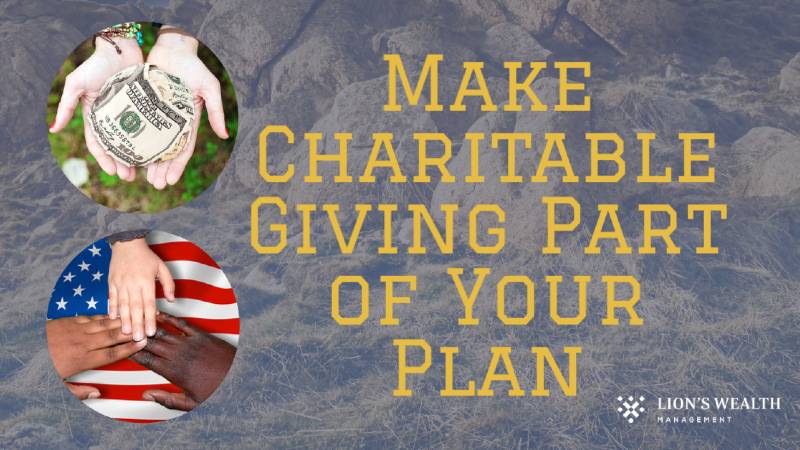
KEY TAKEAWAYS
Making charitable giving a part of your financial plan is a great way to ensure you have a tax-efficient way to manage your finances. Whether you set up a donor-advised fund, transfer your RMDs, or set up a pooled income fund, there are many ways to give to charity in your financial plan.
Find Qualified Charities
Not all charities are created equal. If you have a charity in mind or a specific cause that’s near and dear to your heart, find a qualified charity.
Qualified means they are a 501(c)(3) charity. You can find out on the IRS website if you aren’t sure. Making sure the charity is a qualified charity is the only way you can deduct the contributions on your taxes.
Set up a Pooled Income Fund
A pooled income fund is a charitable trust you set up while you’re alive. You can transfer cash, stocks, or mutual funds to the pooled income fund. You get an immediate partial tax deduction based on the asset’s fair market value and your current life expectancy. You also avoid any capital gains taxes on assets you transfer over.
While you are alive, you earn dividend income, which you do owe taxes on, but the remainder of the fund grows for your intended charity. Upon your passing, the entire amount goes to charity and decreases your total estate value, which helps offset your estate’s tax liabilities too.
Set up a Donor-Advised Fund
A donor-advised fund provides you with tax benefits while allowing you to give to charities directly from the fund.
You control when you get the tax deduction as well as when you contribute. If you want to contribute a lump sum that carries your regular donations through the next few years or longer, you can.
When you contribute to a donor-advised fund, you get the tax deduction immediately. The funds grow tax-free too. You don’t pay capital gains taxes on any gains. You also aren’t under any time constraints to donate the funds. You can contribute as much as you want and space the contributions out as much as you want.
A donor-advised fund is a great way to offset large tax liabilities, especially in years when you receive large windfalls.
Direct your Life Insurance to a Charity
If your legacy is to give a part of your estate to a charity, set your life insurance up with the charity of your choice as the beneficiary. Upon your passing, the charity will have full control of the proceeds of the insurance policy. This may also help you reduce your tax liabilities, especially on any premiums you pay after naming the charity as the beneficiary.
Gift your Required Minimum Distributions
If you have traditional IRAs or 401Ks, you owe taxes on the withdrawals you make. If you don’t withdraw enough money by the time you’re 72 years old, you’ll be forced to take Required Minimum Distributions.
The amount you must withdraw varies based on your age and life expectancy. With the Qualified Charitable Distribution, you can steer your RMDs to a charity. With a direct transfer from your retirement account to the charity, you bypass the tax liability. There are no taxes incurred on direct transfers.
Set up a Charitable Trust
Different charitable trusts have different tax liabilities and requirements. A charitable trust can be an important part of a financial plan because they help minimize tax liabilities while giving to a charity of your choice.
A charitable trust is a great way to leave behind a legacy and/or transfer money between generations. You can transfer appreciated assets to the trust, which then avoids capital gains taxes and you receive a tax deduction on the fair market value of the asset when it’s contributed.
Give a Charitable Gift Annuity
A charitable gift annuity is a contract between you and a charity. You agree to contribute cash or donate specific assets. In exchange, you receive a partial tax deduction based on the asset’s fair market value when you donate it and the dividend income you receive from the asset.
Upon your death, the charity then has full control of the funds. It’s a great way to earn a small income while you’re alive and giving to your favorite charity upon your death, as a part of your legacy.
Why you Should Add Charitable Giving to your Financial Plan
It’s a smart strategy to include charitable giving in your financial plan. You know that you’re making a difference now (and after your death). You set up plans that provide a lifetime of income streams while ensuring that the remainder of the assets goes to charity.’
You decrease your tax liabilities while doing good for the world. It’s a great way to ensure regular contributions to charity while making the most of your tax situation both now and upon your passing.
Bottom Line
If you are interested in charitable giving as a part of your financial plan, make sure you make a tax-efficient plan. Not all charitable contributions are tax-efficient. Talking to a licensed financial advisor ensures that you make the choices that not only help you now but also your beneficiaries upon your death.
Always make sure you give to a qualified charity (checking with the IRS if you aren’t sure), and know the tax consequences or benefits of the contributions. Timing your contributions just right, and knowing how to transfer the funds, such as RMDs so that you don’t trigger any type of tax consequence is the best way to ensure that you make the most out of your money while doing good in the world.
